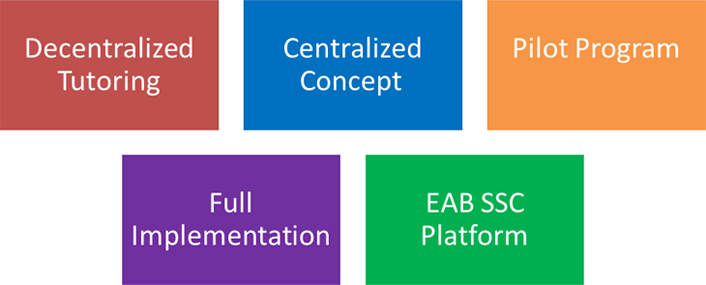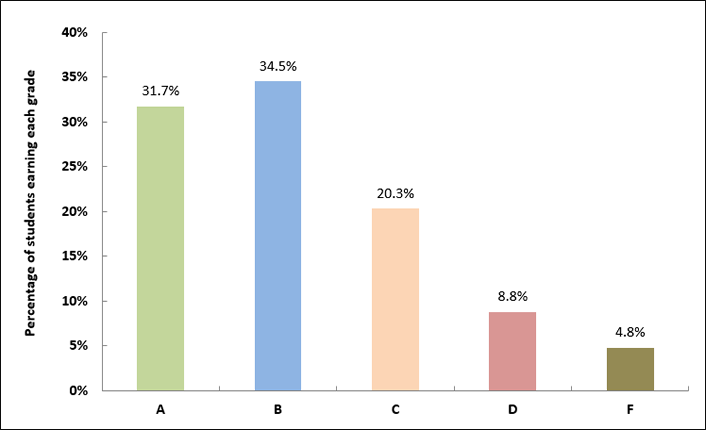Hear how one institution used tutorial support — including an increase of 126% for its tutoring program — to improve student retention and graduation rates.

Student Success at MTSU
Middle Tennessee State University (MTSU) is a recognized leader for our student success initiatives. Student success is central to our mission at MTSU; as such, top priority is given to improving student retention and graduation outcomes. In 2013, our leadership team adopted a blueprint called Quest for Student Success, which is a comprehensive, strategic initiative designed to improve these outcomes. The blueprint identified four strategic directions:
- Advising enhancements
- Communication plans and systems
- Course redesign
- Tutoring
An emphasis was placed on tutoring as one of the more immediate strategies to improve student retention and, subsequently, graduation rates.
Evolution of Tutoring
Initially, there were traces of tutoring happening at MTSU. It was decentralized and occurred only in some departments on campus. In 2012, there was a discussion to implement a centralized tutoring concept. Research of best practices suggests that tutorial support should be made available in a central location [https://learnlab.hfcc.edu/files/ttfreportfinaldraft06.22.2011.pdf] and that centralized programs at four-year institutions are a key reason students earned higher first-term and cumulative GPAs compared to students who participated in decentralized programs.
After reaching out to two key resources — academic department chairs and advisors — a study was conducted at that time to assess our available campus tutoring resources. The purpose was to reevaluate how tutoring was done on campus and consider offering it in a centralized location. One idea involved offering tutoring services in the library. This way, students could have the ability to drop in and get help as needed. The study resulted in buy-in, and the rest is history. Centralized tutoring was piloted in 2013 at MTSU and subsequently was fully implemented (see figure 1).

This Is How We Do It
Students must have their ID to use the free tutoring services. The three primary reasons are:
- Ensuring we are serving current MTSU students
- Mitigating any safety concerns
- Tracking and reporting purposes
A card reader is used for tutees to swipe in with their ID when they begin a session and swipe out when the session concludes. Desk assistants are hired to staff the front desk during official tutoring hours and monitor the activity. Tutors also sign in and out for time-keeping purposes.
Because we are a large institution, a College Liaison represents each college that offers tutoring. Periodic meetings are held for updates and other issues. A monthly budget report is sent to each liaison so that each area can monitor its tutoring expenditures. An online database provides available tutoring opportunities to students.
Elevating Awareness on Campus
Surprisingly, some students still do not know that tutoring is available on their campus, and this was true at MTSU. To remedy this, our team brainstormed ways to raise awareness, and one idea was to have someone waving and flipping big signs, as done at some businesses. We turned this idea into a big festive event with a catchy theme: MT Flips over Tutoring. We are fortunate to be at an institution where our president, provost, deans, and other top administrators participated in this innovative "flipping" event. It included an informational tent, music, refreshments, and tutoring swag. In terms of engagement and turnout, it was a huge success! (You can view a snippet of this lively, festive event.)
We also employed five other methods to elevate awareness:
- Yard signs in prominent outdoor locations
- Napkin holders (in key campus dining venues)
- Postcards (used at university events)
- Flyers (for display in strategic areas and university events)
- Social media promotions
Listen to Your Students
Some students did not have the foundation of knowing how to study. They often ask, "How can I learn how to study?" or say, "I don't know how to study." This resonated with us and was concerning. To remedy this, we developed a track called Study Skills and Learning Strategies. Early indicators showed that the grade point average for students attending tutoring in Study Skills was higher compared to a sample group. (Learn more about how MTSU tutors new students how to study and how MTSU's free tutoring focuses on study skills and student success.)
Because some students were still experiencing difficulty, D2L usage and Reflective Writing were added to Study Skills last fall. E-portfolio tutoring will be launched as a pilot in fall 2018.
The Study Skills program at MTSU has experienced tremendous growth since its inception just one year ago. We are proud to report that student usage has increased by 144%!
Measures of Success — It Works!
How do you know if your tutoring program is working for you, or if it is successful? We measure our program's success in three ways:
- Utilization
- Student Retention
- Grades
Utilization
As mentioned, card swipes from student IDs track tutoring usage. We use the Banner system and generate reports using Argos. Based on fall 2017 data, tutoring utilization — that is, total sessions and hours spent — grew by an astounding 74% and 78%, respectively, compared to the 2016 fall semester (see table 1).
Table 1. Utilization of tutoring program
|
|
2015 |
2016 |
2017 |
|---|---|---|---|
|
Total Sessions |
4,892 |
6,338 |
11,040 |
|
Hours Spent |
7,082 |
8,735 |
15,557 |
In just two years, the total sessions and hours spent in tutoring grew by an amazing 126% and 120%, respectively (see table 2).
Table 2. Growth of tutoring program
|
|
One-Year Change |
Two-Year Change |
|---|---|---|
|
Total Sessions |
74% |
126% |
|
Hours Spent |
78% |
120% |
Retention
Data continue to show the positive impact of tutoring on student retention at MTSU, particularly at the freshman and sophomore level. In fall 2016, both were retained at 17 percentage points higher than those in the comparative group that did not participate in tutoring. Similarly, in fall 2017, freshmen were retained at 14 percentage points higher.
Grades
Another way that we measure tutoring success is grades. We are excited that, based on fall 2017 data, nearly all students who participated in tutoring passed the course. Almost 90% passed with a grade of C or higher; 66% with B or higher, and 32% with an A. (That's huge progress!)

MTSU is currently taking tutoring to the next level with integration into the Education Advisory Board (EAB) Student Success Collaborative (SSC) platform. Tutoring went live with student check-ins this semester to pilot the new system.
Cornelia Wills is the Director for student success at Middle Tennessee State University.
© 2018 Cornelia Wills. The text of this work is licensed under a Creative Commons BY-NC-ND 4.0 International License.
